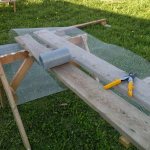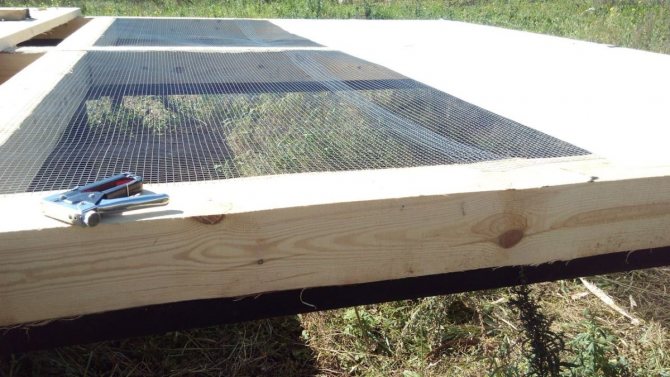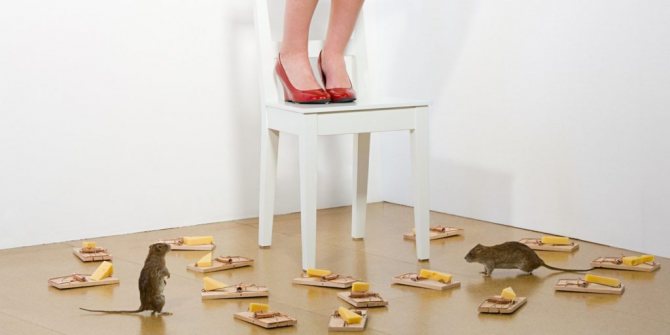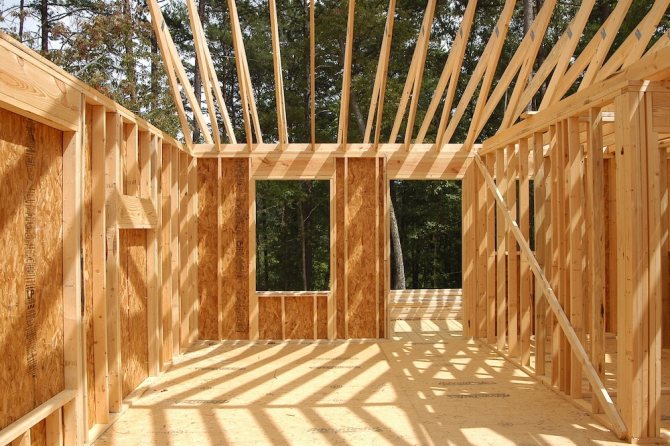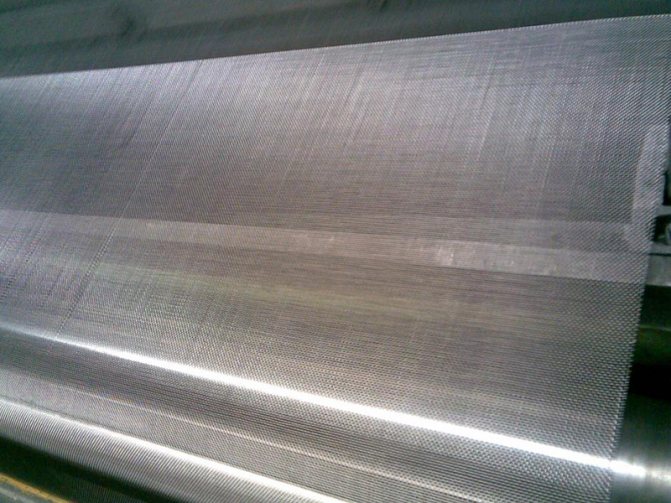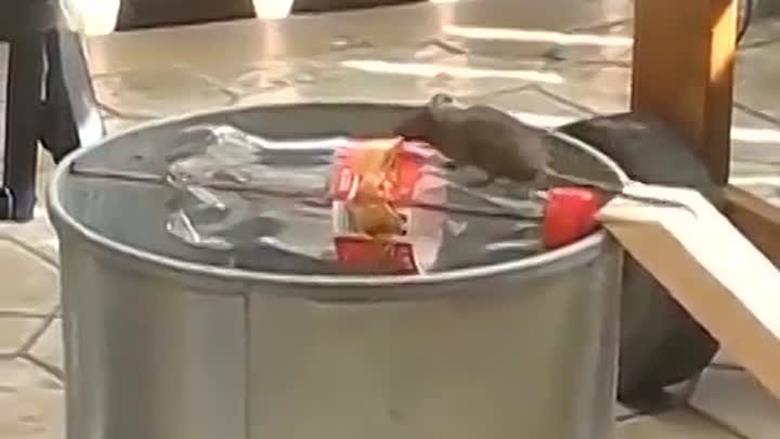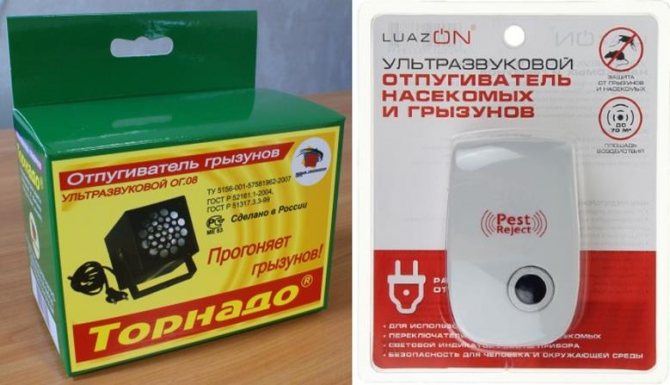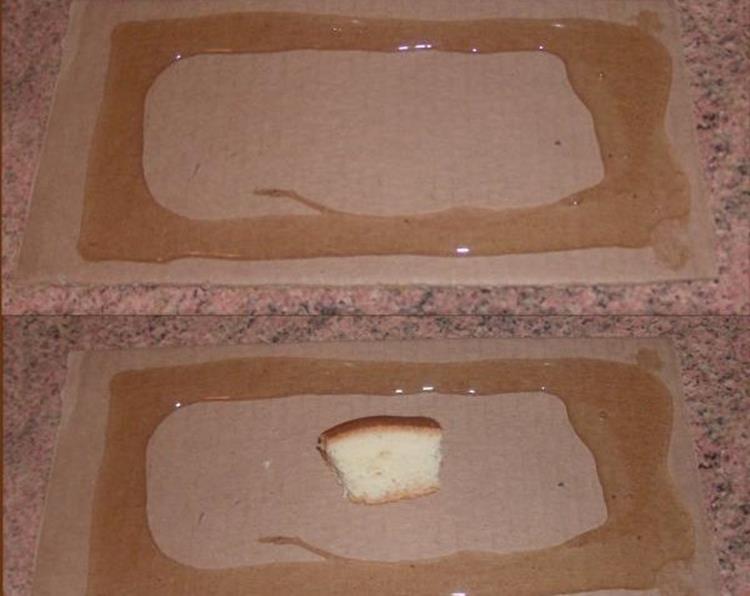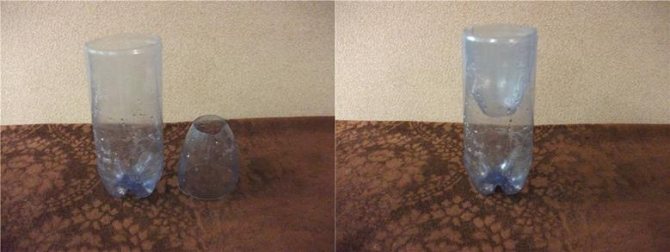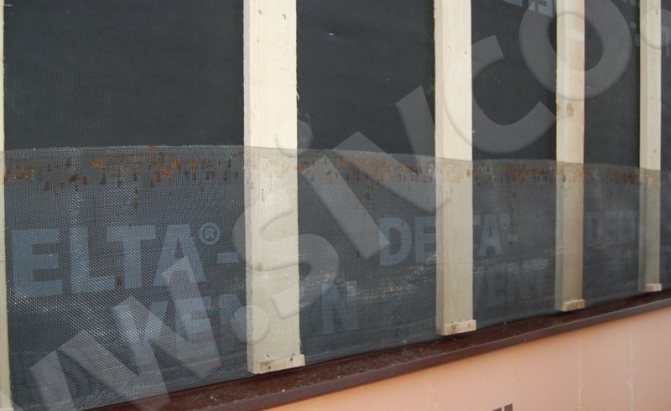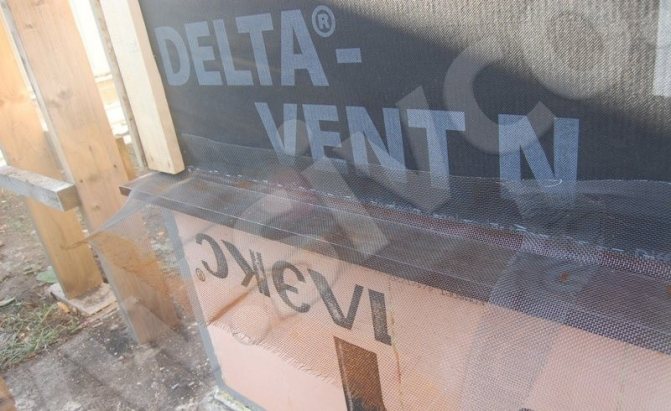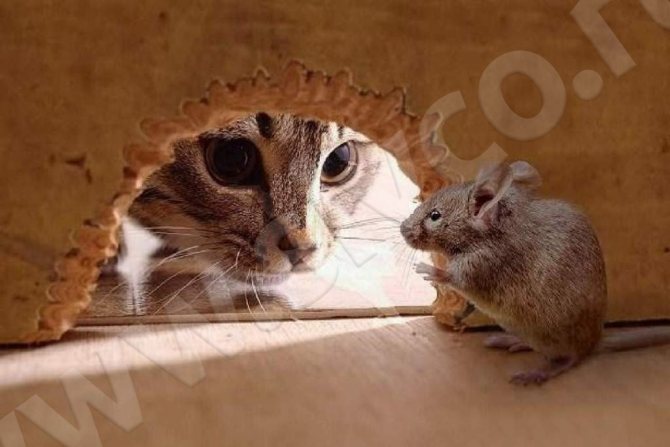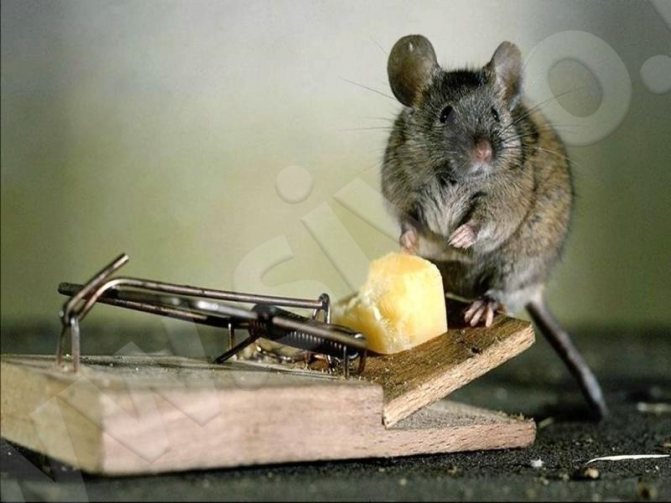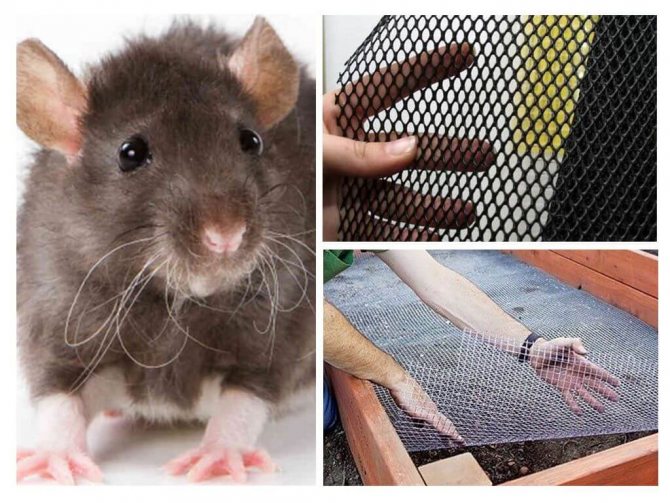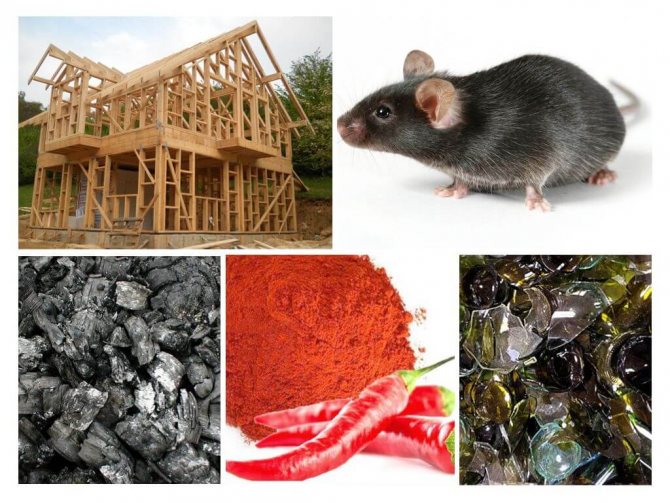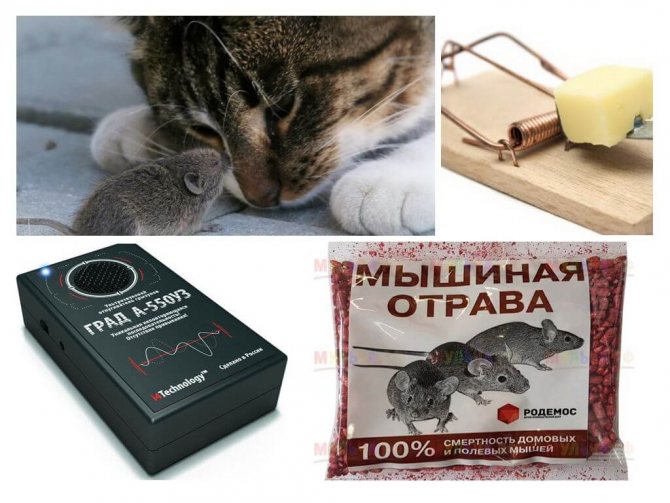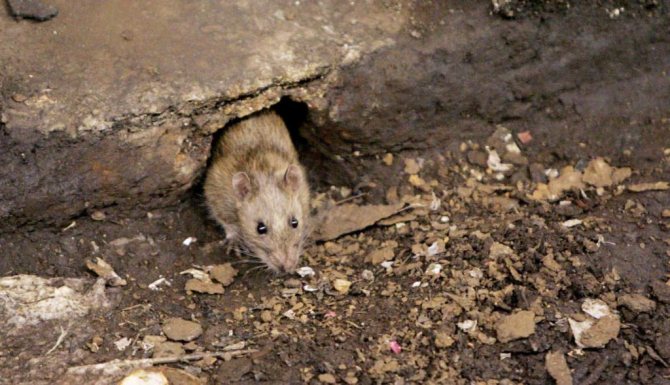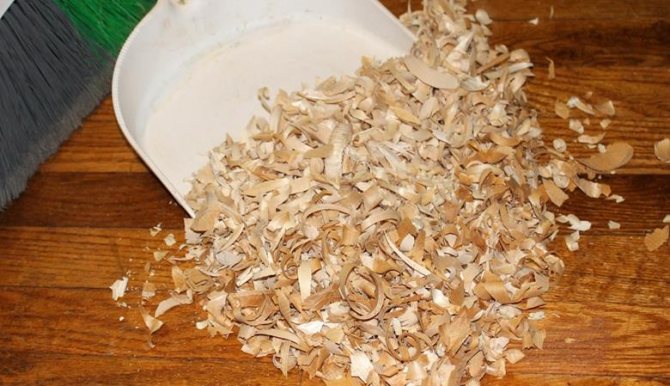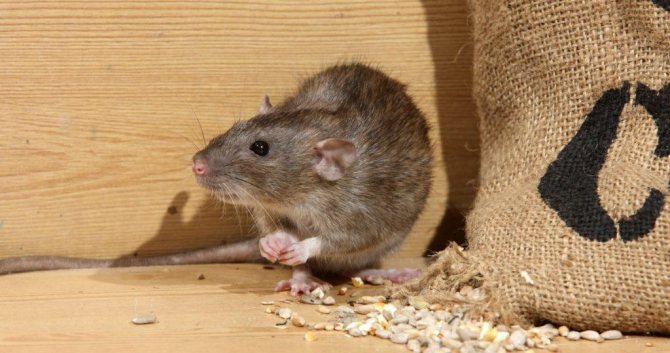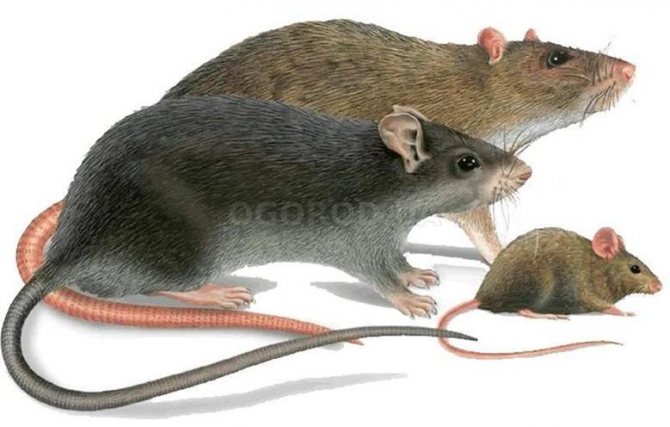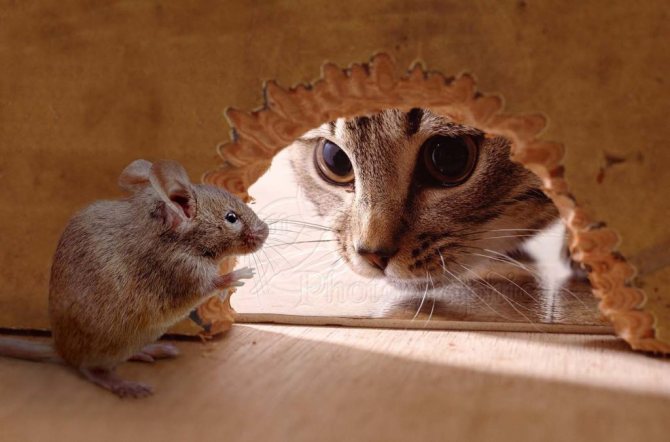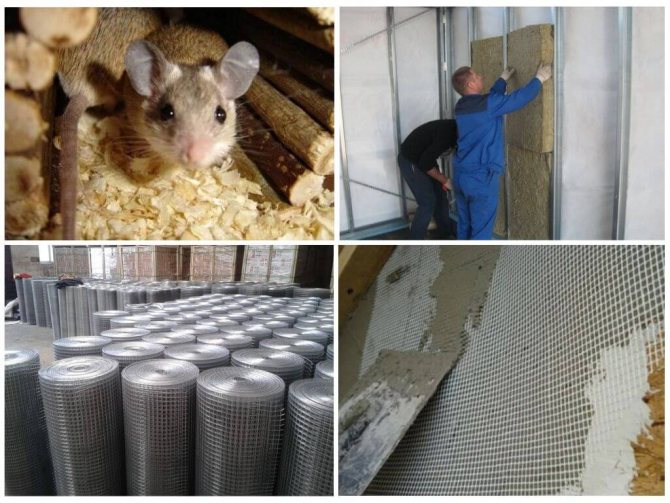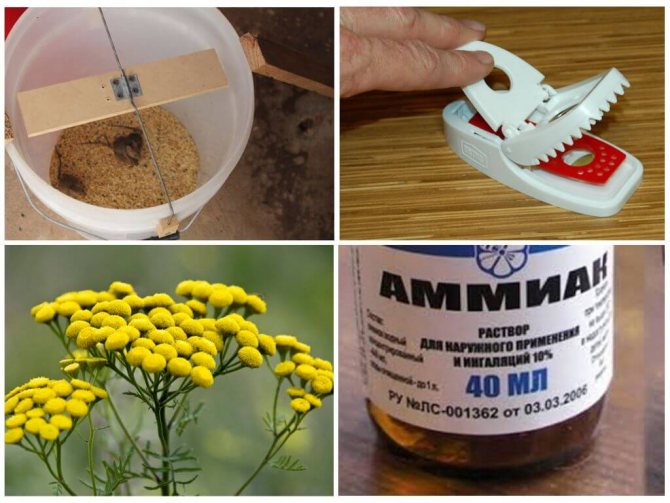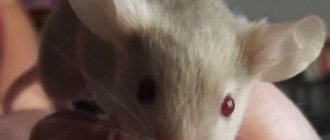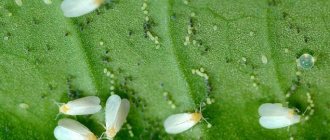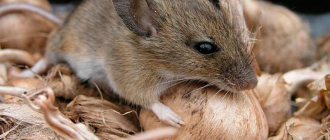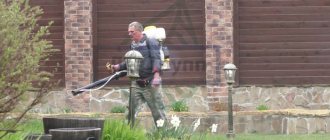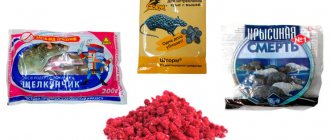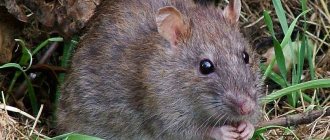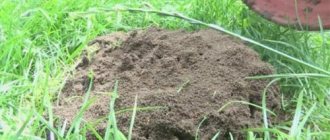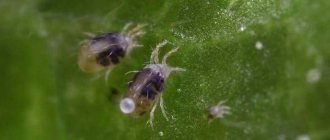Frame technology is one of the most widespread methods of low-rise housing construction in developed countries of Europe and America. The use of energy-efficient, lightweight, safe and durable materials allows, in the shortest possible time, regardless of the season, to build a cozy and practical mansion of frame-panel type. A convenient and original in terms of configuration, the frame could be called perfect in all respects, if not for one nuance - mice in a frame house.
Mice can live in a subfield, insulation, which is used to protect the building from negative weather influences. In order to prevent the penetration of mice and other pests into the home, it is necessary to take care of this even at the stage of forming the foundation of the future home.
On a note!
The SIP method (Canada) is especially popular with developers, thanks to which low-rise new buildings are distinguished by high rates of heat and sound insulation, vapor permeability and fire safety. It is possible to build and operate such structures in places with a temperature background from -60 to + 60 ° C. They are not afraid of any natural disasters, they can serve their owners for about 100 years.
Where do the mice go?
The frame house, due to the peculiarities of the construction, is an attractive place for a rodent to stay. A wooden or, less often, a metal frame made of racks, support beams, struts is sheathed from the outside and inside with protective and finishing materials. Slab insulation is laid inside the hollow walls. The floors are often arranged along logs, between which thermal insulation is placed in the form of rolls or slabs.
The technology involves the device of ventilation gaps to remove condensate and air circulation in structures. This protects them from rotting, moisture accumulation.
At the same time, all cracks and technological gaps are an accessible way for mice to enter. A favorite habitat is insulation plates. Rodents lay passages in them, arrange nests, and breed numerous offspring.
Mouse fuss is annoying, but in addition to this, considerable harm is done to the insulation. The structure loosens and disintegrates over time, which leads to a loss of thermal insulation properties.
Studies carried out in the USA at the University of Fish Culture, Forest Science and Wildlife, found that for six months of rodent activity, the thermal conductivity of the insulation increases 5 times.
The experiment involved families of house mice. They were planted for 6 months in imitation of walls insulated with common types of insulators for frame, brick and concrete houses - extruded polystyrene foam, basalt or glass wool, vermiculite, cellulose ecowool. Foil vapor barriers and isocyanate did not stop the sharp teeth.
Dangerous neighborhood with mice for electrical wiring. Breaking the insulation from the sharp teeth of rodents can lead to a short circuit and even a fire.
Wooden structures - elements of the frame, floors, ceilings - are seriously damaged by gray animals. These are undesirable phenomena leading to a gradual loss of strength, a violation of the aesthetic appearance of the finish.
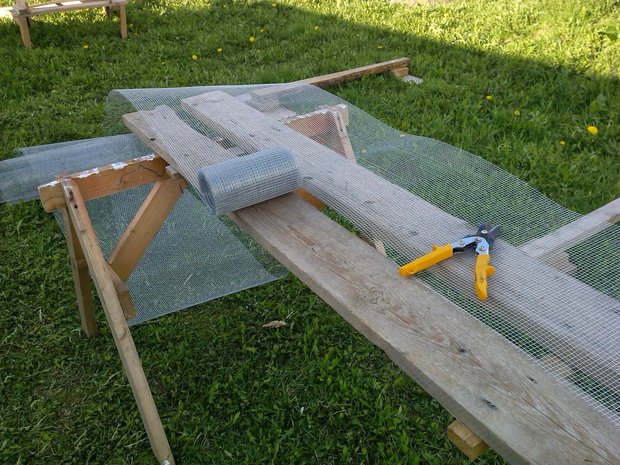
How to get rid of insects in a frame house?
When the wooden frame of the building is already infected with insects, it is allowed to use the following methods of dealing with them:
- Chemical;
- Biological;
- Mechanical;
- Ultrasonic and electromagnetic radiation.
If you cannot get rid of insects on your own, experts advise contacting specialized pest control services. The main thing here is to start fighting as early as possible, before they managed to multiply to unthinkable limits and cause irreparable damage to the main structural elements of the frame house.
Formidable enemies
House mice are the largest population of mammals. They reach a length of 9.5 cm and a weight of 30 g. Due to the property of synanthropy - coexistence with a person - they are perfectly adapted to his lifestyle and housing. They live everywhere, except for the regions of the Far North and Antarctica.
A little mouse can run 5 km in search of a suitable accommodation. She is especially active in late summer and autumn, as she does not like cold weather very much. It digs holes in the ground to a depth of 60 cm. It moves along constant routes, leaves paths of dust and droppings, holding them together with urine. Its specific smell betrays the existence of a rodent in the room.
Mice settle in families where there are several females for one dominant male. The individual area around the nest is 900-1200 m². Rodents try not to leave the boundaries of the site.
House mice run fast, climb well, jump, swim.
They breed all year round. One female is able to bring up to 120 cubs per year.
The centuries-old neighborhood of a mouse and a person is an indisputable fact. But the fact that 80% of the rodent genome coincides with the human is still a mystery. This feature is used in science to study diseases and methods of their treatment. The Methuselah Foundation for Aging awarded the Lab Mouse Five-Year Longevity Record Award in 2005. A monument was erected to her in the Novosibirsk Academgorodok.
The closest "comrades-in-arms" of the house mouse are gray and black synanthropic rats. Their way of life is similar to that of a mouse, but the damage done to the farm is many times greater. Rodents, without any harm to their own health, damage lead and aluminum pipes, live cables, creating emergency situations in transport and communication networks.
A feature of a large rodent is the ability to adapt to poisons and the ability to think abstractly. Thanks to this, the pest population is constantly growing, despite the active struggle - deratization.
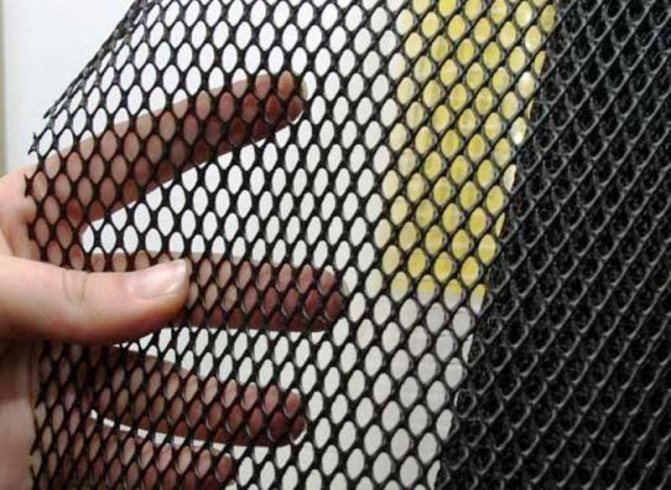

Other methods
The struggle of man with rodents has been going on for many centuries. People are constantly coming up with new ways to protect the house and property from damage by pests. So, burnt wooden bars and branches are laid under the flooring. The smell of burnt wood scares off mice. In addition, you can use other aromatic repellents - pine, mint, tobacco, added to the insulation. Red hot pepper is poured around the perimeter of the house and, if possible, into the walls. It is also known that rodents do not tolerate the smell of burnt wool. The old method is to put a piece of wool in an old unnecessary saucepan, make a few holes in the saucepan and set the wool on fire, then put this container in the basement. The smoke smell will slowly spread throughout your home, chasing the pests away.
A source
Why are rodents dangerous?
Not only building structures, but also food supplies suffer from mice and rats. Having made their way into the storage, animals are able to quickly destroy or contaminate cereals, vegetables, fruits. They do not neglect anything, even soap, candles and glue, although they belong to the species of rodents. In nature, plant seeds form the basis of their diet.
Clothes, shoes, books, furniture, when "meeting" with mice, become unsuitable for further use.
Neighborhood with rodents is dangerous to humans.Mice and rats carry severe, even fatal infections - pseudotuberculosis, plague, leptospirosis, tularemia. Infection occurs through contact with feces or the bite of blood-sucking arthropods that live on animals and easily pass to humans.
Recent studies have confirmed that the virus that causes mice mammary glands is infectious to humans and contributes to the development of breast cancer.
The right choice of insulation
Many people choose expanded polystyrene as insulation, since its cost is low and allows you to save money. But this is not the best option. Rodents will quickly gnaw through this material if they decide to climb into your home. If possible, it is better to combine expanded polystyrene with mineral wool, although this does not always solve the problem. Experts recommend using ecowool to insulate the structure. This is a material with a high degree of adhesion, it tightly fills even small gaps, although it is much more expensive. The use of ecowool will reduce the likelihood of rodents entering the house. In addition, the material does not generate dust, does not contain components hazardous to humans.
Important: ecowool is difficult to install, so it should be applied by a specialist who is familiar with the technology of such work. In case of errors in application, the material may lose its properties and shrink.
Metal nets - a barrier for rodents
To meet with mice and rats on your territory as rarely as possible, you need to make housing inaccessible to outside penetration. The protection of frame houses from rodents is carried out in a comprehensive manner - from the construction of the foundation to the extermination of pests when they appear.
To prevent mice from entering the house, galvanized metal nets with a mesh of up to 6 mm are used. This size is due to the ability of the animal's skull to flatten to a minimum volume. Plastic protection is not reliable, rodents will easily deal with it.
Expanded metal meshes are perfect for this purpose. Even small rodents will not be able to squeeze through a small hole. They are made of sheet metal with a thickness of 0.45-0.50 mm by cutting through diamond-shaped cells, followed by stretching. The product is abbreviated as CPVS - all-metal expanded mesh.
The main application is the reinforcement of putties and plasters, but recently it has been widely used as protection of frame houses from mice and rats. CPVS weighs little, does not creep when deformed. It is durable, resistant to corrosion and the sharp teeth of rodents.
Directly to the frame, the mesh is attached with staples using a construction stapler or self-tapping screws with press washers. For installation on thermal insulation, special elongated clamps are used.
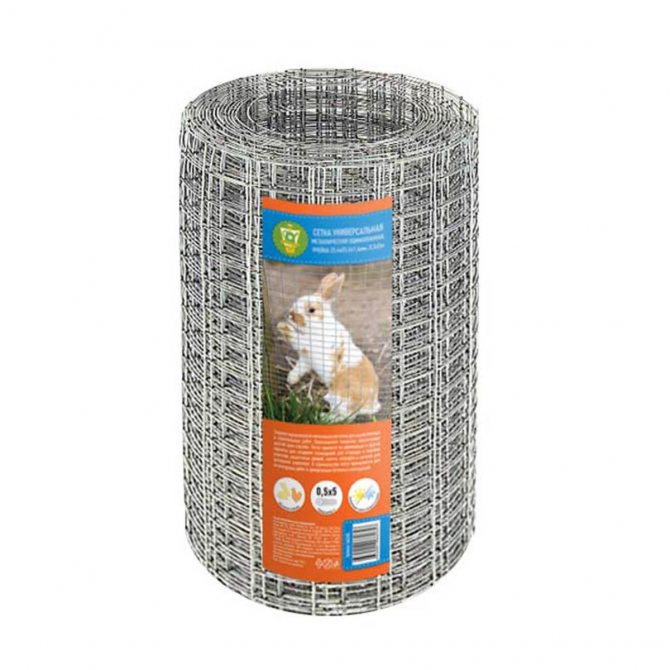

The price of the material is available - 70-160 rubles / m². The investment pays off with a restful sleep, saved nerves and funds.
In addition to CPVS, woven meshes with a mesh of up to 6 mm and a wire thickness of 1.2 mm are used. They are more expensive - up to 250 rubles / m², but a more powerful metal is able to stop not only mice, but also rats.
Rodents can go deep into the ground up to 50-60 cm. They penetrate the house through cracks in the foundation, basement and floors, so the main protection should be located at the level of these structures.
Professionals who have built more than a dozen frame frames advise how to protect a frame house from rodents using a mesh:
- Fasten the vertical underground curtain along the perimeter along the basement and foundation to a depth of at least 100 cm;
- Lay on the subfloor with a layer preceding the insulation so that mice cannot get into it and settle;
- To beat the outer corners of the building before finishing;
- Close ventilation gaps, chimneys, foundation air vents and other technological openings.
Potential entry points for rodents will be closed by an impenetrable barrier for them.The main requirements for the mesh are the mesh size - up to 6 mm and a sufficient thickness of the zinc layer. The mouse can easily crawl into larger holes, and the poor quality of galvanizing will lead to the rapid destruction of the base metal.
So that the mouse does not slip
Small rodents willingly equip nests in the ceilings and walls of a frame structure with an impressive layer of loose insulation. It is necessary to provide for the protection of the house from mice even at the construction stage and not allow them to penetrate into the structure, since then it is extremely difficult to expel intruders. Otherwise, gluttonous pests will spoil the insulation, attack food supplies. It is also worth remembering that mice are carriers of infections dangerous to humans, which are spread by air.
Reliable ways from rodents
If mice appear in the house, then you can use traditional methods - poisoned baits, tobacco dust, mint, mousetraps, or more modern - ultrasonic repellents. But the most effective way is to prevent pest penetration by installing protection during the construction phase.
Reinforced concrete slab
The monolithic reinforced concrete foundation is a solid foundation of the building and an insurmountable obstacle for the teeth of rodents. Mice and rats will not be able to penetrate through a reinforced plate 25-30 cm thick. The rest of the paths can be protected with a fine mesh.
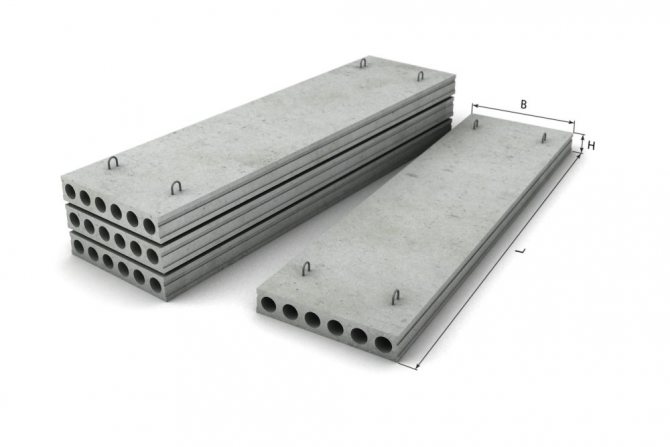

Expanded clay
The sub-floor, arranged along the ground, can be made impassable for rats and mice using expanded clay.
Expanded clay is poured onto the prepared base with a layer of 25-45 cm. A 3-5 cm thick layer of lean concrete is laid on top or spilled with cement mortar. Then a dense waterproofing film or membrane is spread. The device of the floors is completed with a screed, gypsum fiber or particle boards, finishing.
Expanded clay is inedible for mice.
They do not lay passages in it, do not arrange nests. They will not be able to settle in the insulation because of its flowability.
Insulation
When choosing a heat insulator for a frame house, such characteristic as damage by rodents is important. There are three categories of insulation, to which mice have different attitudes.
They never touch the first. This is foam glass in granules and slabs, glass wool, ecowool. Materials based on silicate raw materials injure the mucous membranes of the mouth. A thin layer of glass wool is enough to stop the rodent. Borax and boric acid, which are used to treat cellulose, are toxic to them. Therefore, the walls of frame houses can be insulated with these heat insulators without fear.
The second category is reluctantly harmed by mice. These are basalt wool, extruded polystyrene foam, liquid expanding polyurethane foam. The materials are inedible for animal pests, but permeable. They make passages through them, use fibers to make nests.
The third type of insulation is the most beloved and habitable by rodents. This includes styrofoam and expanded polystyrene. In light warm materials, gray pests arrange vast labyrinths and nests, in which numerous cubs are hatched.
To prevent uninvited residents from settling in the frame house, high-quality high-density materials are chosen for insulation.
The tougher they are, the less they attract rodents.
Metal bumpers
Used for protection from mice in houses on pile or strip foundations. They are circular ebb tides installed along the perimeter of the building at the level of the top of the basement. Their width is at least 36 cm.
A continuous strip of smooth metal 40-45 cm high will prevent rodents from climbing up the walls.
Some builders recommend mounting the base for the rough floor of a frame house on a pile foundation from steel sheets, for example, a profiled sheet. This is a reliable way to close access to housing for animals.
The reasons for the appearance of rodents in the structure
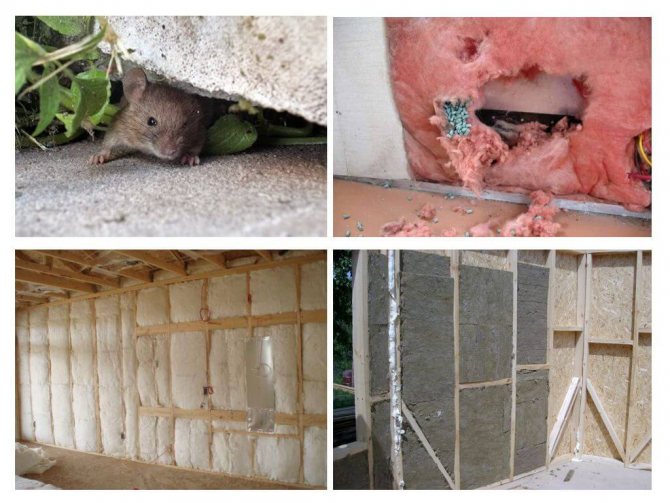

Mice in a frame house Mice can enter a house that uses wood as a frame for many reasons. Most often, human habitation attracts them by the presence of food. Here they can find a safe refuge from the winter cold. House mice penetrate into frame houses quite easily, due to the fact that it is almost impossible to avoid cracks in the floor, as well as at the joints of the structure.
Another factor is the wall lathing used in the finishing process. The resulting voids are filled with insulation. If it is incorrectly installed or belongs to cheap goods, then it may well become a reliable shelter for mice. To prevent rodents from choosing a frame house, it is necessary to use insulation that mice do not gnaw.
Important!
Hungry rodents are attracted by the smell of food, to which they are ready to wade through any obstacles. Store food in safe packaging. If the mice realize that there is nothing to eat in the house, they will leave it.
Nearby trash cans can attract pests to a frame house. To protect home ownership from rodents, it is necessary to set aside the territory for various household waste away from the cottage.
House without mice
The ideal rodent-free home sits on a raised platform, away from trash heaps and pet barns. Corners, foundation, plinth, technological openings are protected by a metal mesh with a fine mesh. Floors on the ground - on a thick layer of expanded clay, on the logs - on the same galvanized mesh. Thermal insulation of walls - dense mineral or foamed ecowool, closed from the penetration of pests in the places of ventilation gaps. The attic floors are insulated with bulk materials with properties that repel mice. Wooden frame elements are treated with a mixture of borax and lime.
The finishing touch. An intelligent cat sits at the doorstep, catching mice for breakfast or out of sport.
Mousetraps and special glue
The use of mousetraps makes the process of fighting rodents in a certain sense creative - the owners acquire a sports interest. There are many devices for trapping mice, and they can also be purchased at hardware stores. Some of them immediately exterminate rodents, some only capture, and the hunter himself will have to tinker with the trapped pests.
The same can be said about special adhesives that are applied in the places of the supposed migration of mice - the mouse stuck to the floor will have to be removed and destroyed with one's own hand.
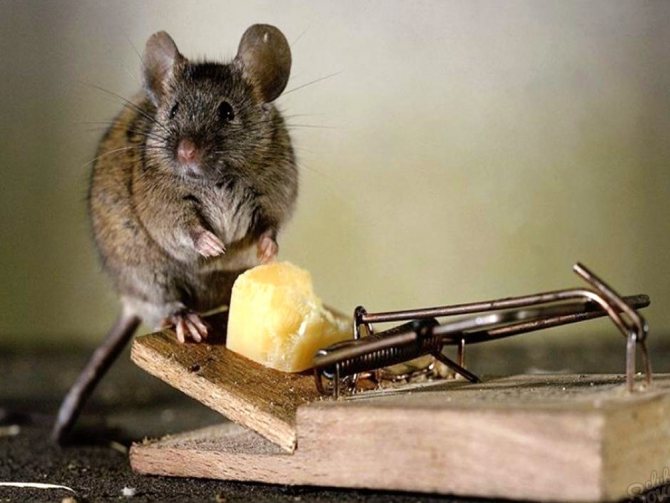

Free Cheese
What harm do rodents do
Mice, rats and other rodents, in the absence of certain protective measures, can easily enter the frame house. By this, they not only frighten the owners who are afraid or disdain such guests, but also bring harm. Destruction can befall any corner of the home. They gnaw through concrete or, wiring, a wide variety of objects in the house. Often, pests destroy stocks for the winter or other food.
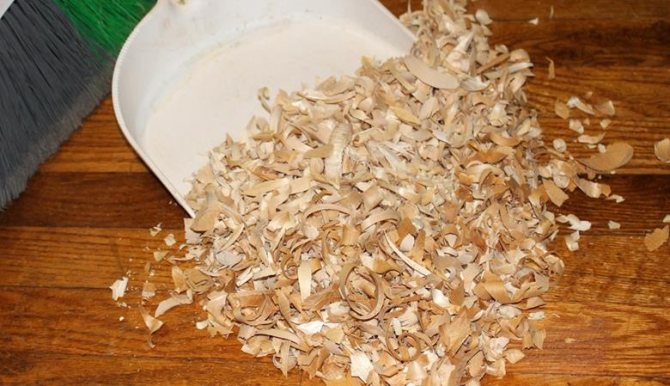

If mice settle in basements, where it is usually damp and dark, they begin to actively reproduce. In this case, it is even more difficult to deal with their huge number. The most dangerous thing is that rodents are carriers of dangerous infectious diseases, for example, cholera, various intestinal diseases, leptospirosis. Therefore, it is necessary to get rid of them as soon as possible, and for this we will get acquainted with the methods of dealing with mice.
Rodent control
If the stage of protecting the house from pests was skipped, and mice still got in the frame, there are several ways to deal with them. How to get rid of mice in a frame house? Most commonly used are mouse traps, traps and rodent-killing chemicals.
Mechanical methods
If there are mice in the frame house, you can resort to the most popular method - install mousetraps.Remember that the method will only bring the proper effect if all the cracks and holes through which the mice originally entered the room are repaired.
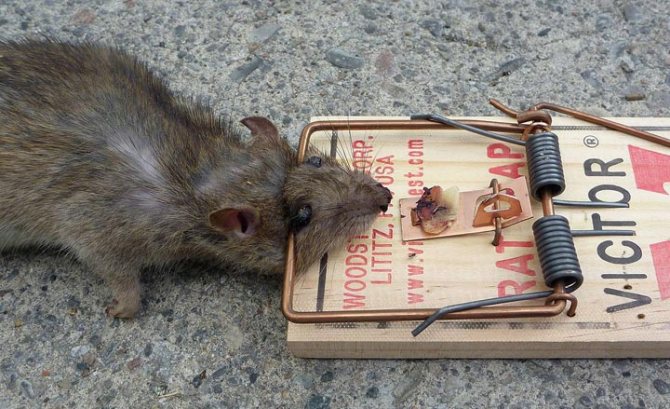

Mousetrap.
Mousetraps have a number of advantages over chemicals: they are safe for children and pets, the rodent will not die in the partitions of a frame house and will not cause an unpleasant odor.
Folk methods
Numerous folk methods of pest control are no less effective:
- Wine stopper. The material is cut into small pieces, mixed with any cereal, a small amount of unrefined sunflower oil is added to the resulting mass. The bait that is eaten by the mouse enters the stomach, where it swells and gets stuck.
- Naphthalene. Rodents simply cannot stand the smell of the substance. To prepare a repellent, it is necessary to mix naphthalene with sawdust and scatter it in the area of minks and pests.
- Semolina. The groats are mixed with dry gypsum or putty, crumbled near the mice. Once in the stomach, the substance hardens and causes the death of the pest.
- Quicklime is mixed with sugar and placed near the burrows. Rodents happily eat the bait. In the stomach, lime reacts with gastric juice, causes severe burns, and causes the death of the mouse.
Ultrasonic methods
It was found that rodents react painfully to high-frequency ultrasound. Modern electronic scarers that operate on mains or battery power. They emit sounds that cause panic in mice, a feeling of physical pain, and make them hurry to leave the room.
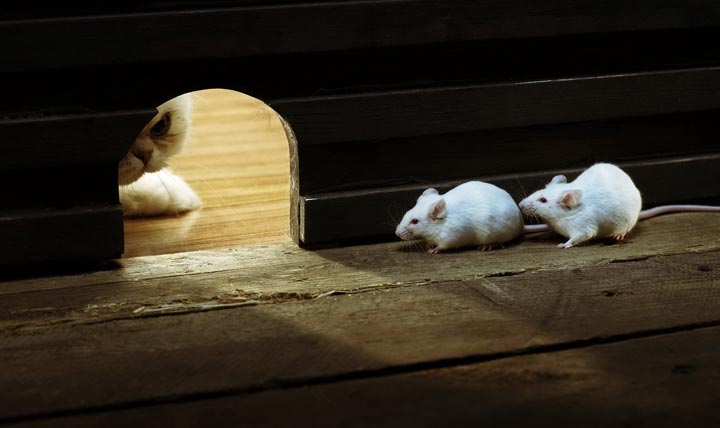

The cat's hunt for mice.
Pay attention to the parameter of the working area of the device, if the power is not enough - rodents will leave only certain rooms.

